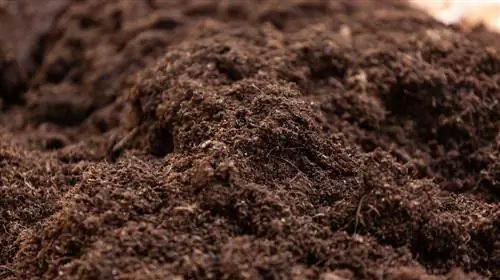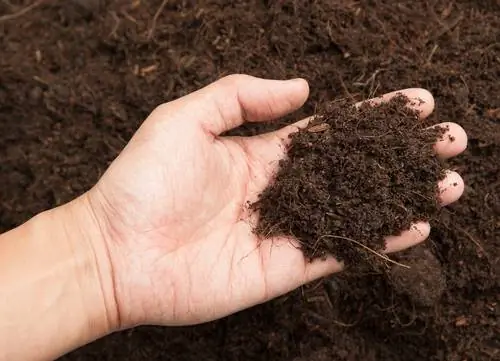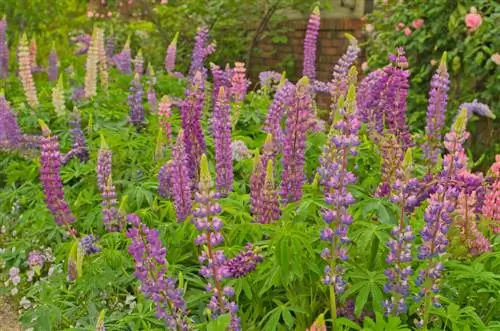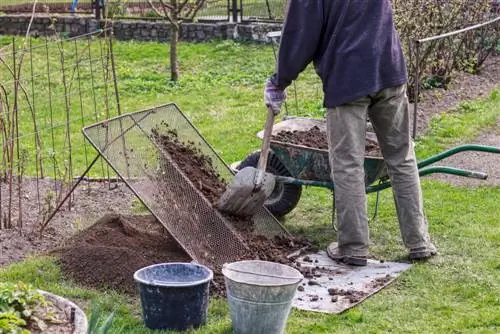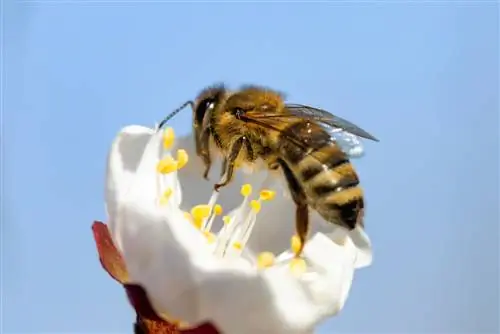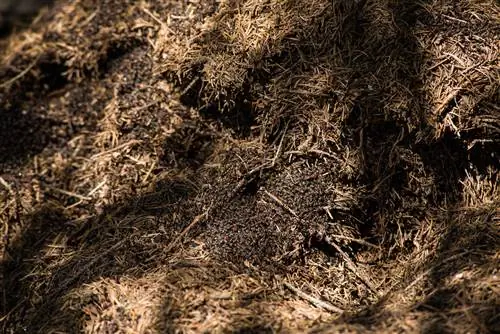- Author admin [email protected].
- Public 2023-12-16 16:46.
- Last modified 2025-06-01 06:02.
Humus - as every amateur gardener knows - is something extremely valuable for the garden. But even some knowledgeable plant experts can't really answer what it is exactly. Below we will take a closer look at what humus is made of, how it is created and what it can do in the garden.
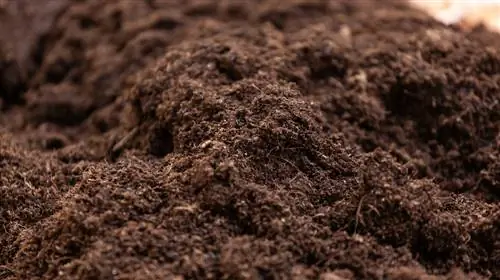
What is humus and what significance does it have for the garden soil?
Humus is the decomposed portion of organic material in the earth, which consists of plant remains and animal remains. It has a fertility-promoting effect and contains important nutrients such as nitrogen, phosphorus and sulfur. Humus improves soil structure and water retention in garden soils.
What exactly is humus?
Defining humus is not difficult at first glance: it actually only refers to the decomposed portion of organic material in the earth, or that which is in the process of decomposition. Its counterpart, or its precursor, is detritus - the undecomposed portion. The remaining portion in mineral soil is made up of living organisms - the biomass.
However, when considering the decomposition process of organic material, things start to get complicated. Because the boundary between decomposed and undecomposed material is floating. And this is mainly because the decomposition process goes through several stages and the exact “time of death” of the material cannot be precisely determined.
During decomposition, two different types of humus are created - nutrient and permanent humus. These types of humus differ in their durability, which is determined by the degradability of their components. Nutrient humus consists of half of quickly degradable carbohydrates and the other half of lignin. Permanent humus, on the other hand - which is basically just a later stage of decomposition - can last for thousands of years as a stable organic substance.
Excursus
Humus content in the soil
The humus content is usually quite low. An average Central European soil (i.e. silty to sandy or clayey loam soil) only contains between 1 and 15% of it. An exception are peat soils (defined as soil with at least 30 centimeters of peat), where the humus content can be around 80%. The majority of the humus lies in the topsoil.
To illustrate the real average values, here is an overview of humus content in the soils of Germany. It comes from the results of a study by the Federal Institute for Geosciences and Natural Resources as part of the project “Organic substance content in topsoils in Germany”. Around 9,000 soil profile data from the three most common types of land use in Germany - arable farming, forestry and forestry and grassland - were evaluated from 1985 to 2005.
| Farmland | Forestry/Forestry | Grassland | |
|---|---|---|---|
| Humus content | 1 to 4% | 2 to 8% | 4 to 15% |
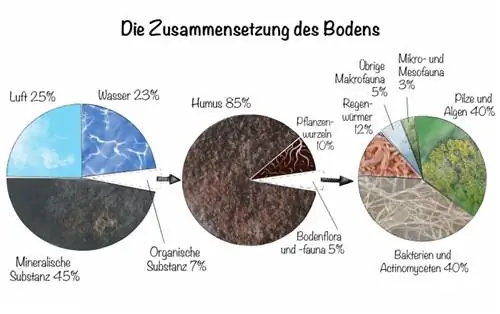
How is humus created?
Humus is created from organic material in the earth - what is that exactly? Primarily, of course, no longer living plants and parts of plants such as dead wood, fallen leaves or root remains. But this also includes the remains of animals, such as skin coverings, bristles or excreta.
During decomposition, the organic material goes through several stages in which various biochemical reactions and mechanical processes take place. These stages are as follows:
1. Preliminary phase
In the preliminary phase of decomposition, only the organism's own substances react with each other, for example in the form of oxidation or hydrolysis. The cell structure still remains intact, which means that the external shape remains.
2. Initial phase
In the initial phase, in addition to other biochemical reactions, there is also mechanical leaching, for example of amino and other acids. The substances released thereby attract a large number of microorganisms that feed on them.
3. Crushing phase
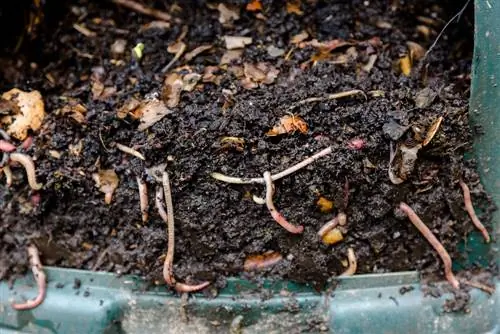
Worms and other insects break down the organic material
In the shredding phase, the material is - no surprise - significantly shredded. Namely the so-called macrofauna, i.e. worms, spiders, insects and snails. They eat parts of the material, excrete it in a different way and work it into the soil.
4. Dismantling and conversion phase
Finally, the fragments are broken down by enzymes. This ultimately also creates inorganic substances such as water or nitrogen dioxide. This process ultimately creates mineral and difficult-to-degrade material such as lignin, which is primarily broken down and converted by fungi. This so-called mineralization (i.e. earthification) is also referred to as the clay-humus complex, i.e. the combination of organic and inorganic fragments. Above all, humic substances combine with clay minerals and ensure the valuable crumb formation of the humus, which ensures its soil-structuring and water- and nutrient-retaining properties.
What is humus made of?
That cannot be answered in general terms. The composition of the organic material that decomposes into humus is always different - depending on the plant and animal species whose legacies come together locally. (and also their age!)
The type of humus is measured primarily based on its nitrogen-carbon ratio. Nitrogen is the valuable growth-promoting component. In addition, humus also contains phosphorus and sulfur, which are also important substances that promote plant growth.
Importance of Humus
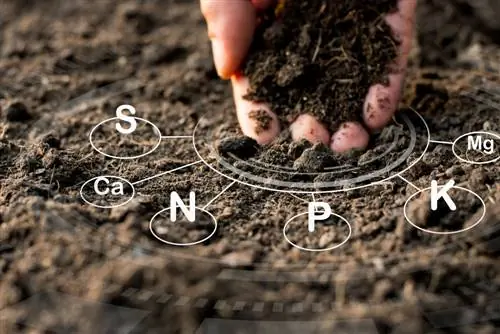
Humus contains many valuable nutrients
Humus has, above all, a water balance-regulating, structure-forming and fertility-promoting importance for the soil. Above all, the substances nitrogen, sulfur and phosphorus it contains are essential for plant growth. In addition, the crumbly consistency of the humus acts like a sponge-like structure, which effectively helps the soil cope with water shortages and excesses. This means that the soil water is available to the flora and fauna for longer and floods can be easily absorbed.
Its porous structure also makes the humus an effective filter for pollutants such as pesticide residues.
Humus can also bind CO2 - for thousands of years.
What is humus used for?
Humus is generally used to enrich the garden soil with nutrients, to store water or prevent drying out and to protect the soil. What this means above all is that important soil organisms, especially the microfauna, feel particularly comfortable under a protective layer of mulch and diligently promote humus enrichment.
When promoting humus in your garden soil, you should note the following:
- apply compost or mulch before winter to protect against the cold and first remove the layer in spring to allow sun and warmth to reach the ground
- particularly dark compost material is beneficial for warming up the soil in spring
- It's better to use your own compost to enrich humus, the raw materials of which you can control. Humus soil from composting plants or conventional agriculture is more often contaminated with chemical pollutants, resins, fungi and weed seeds. If you make compost and therefore your humus yourself and garden consistently without using chemical pesticides, you will get the best “organic humus”.
- An additional inoculation with nitrogen-containing plant manure (especially from nettles) in spring makes mulch application even more effective. Above all, it gives plants an initial growth spurt when sowing
- Apply a layer of mulch thick enough so that weeds have no chance of taking over the area.
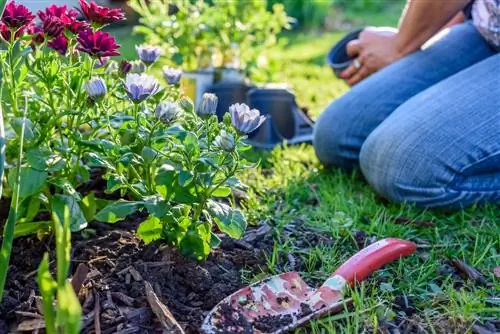
Mulch protects against weeds and drying out
There are - apart from nutrient and permanent humus - many other distinctions within the humus cosmos. A distinction is made primarily between the composition of the starting materials and the resulting effects. Different plants and animal remains contain different substances that have a corresponding effect on the soil.
If you want to make humus yourself, the best way to do this is through standard gardening composting and incorporating the compost soil into the soil, where humus can then be created with the help of the local soil fauna and minerals. Even simple mulching creates a nourishing humus layer on the topsoil. Depending on what raw materials the compost is made of, a different humus is created. Leaves are one of the most important mulching materials because they also contribute significantly to the formation of humus in nature. Basically you can say the following in this regard:
- Fruit tree or beech leaves plus grass clippings and other nitrogen-containing material (e.g. manure): for plants in need of nutrients, especially vegetables
- Oak leaves together with bark and wood cuttings: for mulching under acid-loving plants such as rhododendrons or berry bushes
- Walnut, plane tree or chestnut leaves: very tannic and difficult to rot, therefore unsuitable for mulching or humus production
Mulching the lawn with your own grass cuttings is a well-suited way to create natural humus directly on the spot. Research has shown that lawns that are regularly cut with a mulching lawnmower develop a more robust turf and are more resistant to competing plants and grass diseases.
Tip
If you want to mulch to build up humus, it is worth chopping up the mulching material well before spreading - for example with a shredder or, for the lawn, directly with a mulching lawn mower. This promotes the decomposition stages and the work of microorganisms and enzymes. This means your garden soil will benefit more quickly from the nourishing, structure-providing and water balance-regulating effects of the resulting humus.
When does humus promotion make sense?
Promoting the humus content in the garden soil basically always makes sense. Especially, of course, if you cultivate a kitchen garden from which you want to produce a lot of crops. It is not for nothing that the compost, through whose production and application you promote the humification of your garden soil, is also referred to as the “gardener's black gold”. In general, a humus content of less than 4% is considered low - farmland soils that have been heavily turned over and leached are usually far lower. Depending on how high or low its density is, your garden soil should ideally have a humus content of over 4%.
If you are not sure how much your garden soil needs a permanent fertility injection, you can specifically test your soil for its humus content. However, this requires certain equipment, as shown in the following video:

Frequently asked questions
What is the difference between humus and compost?
The differentiation actually only lies in the impetus for its creation: in the case of humus it is initiated by nature, in the case of compost it is initiated by humans. People create their compost heap separately from the natural soil (e.g. in a compost heap or on a simple pile) specifically to improve their garden soil and count on the help of microorganisms. Humus, on the other hand, is a pure work of nature and naturally forms bonds with minerals and locally occurring microorganisms. When compost is incorporated into the garden soil, it gradually turns into real humus.
How can you make humus yourself?
That has basically already been answered with the previous question: Real humus is only created through natural decomposition by local minerals and microorganisms in the earth. You can only “make” humus yourself by giving the natural soil the task to do it. If you have compost that is already at an advanced stage of decomposition and work it into the soil, you will get real humus wherever you want it: in the vegetable and flower beds or in the lawn.
Where can you get humus garden soil in larger quantities?
You can get large amounts of compost for the garden from waste management companies orseparate humus and earth plants. As a rule, the valuable, nutrient-rich and structure-forming soil is sold as compost soil and not as humus soil because, strictly speaking, one can only speak of humus if it has remained in the natural soil for a longer period of time and continues to decompose locally. You can usually pick up compost soil from humus and soil factories for prices between 5 and 10 euros per cubic meter (not by weight). An individual delivery often requires a reasonable transport fee.
Where can you get humus soil cheaply?
Large hardware stores such as Obi or Hornbach offer compost soil with humus content very cheaply. But it's better not to be seduced by a low price. Because and often the offers are industrial humus from composting plants, which is not insignificantly contaminated with residues of chemical pesticides, weed seeds, fungal spores and even plastic and small amounts of heavy metals that come from incorrectly stocked organic waste bins. You can get your humus through your own composting completely free of charge and, if you carefully manage your garden waste, free of harmful substances - the price here is just patience.
How do you recognize good hummus?
To distinguish good humus from less good humus, you can simply do sensory tests. Rely on your nose, your hands and your eyes. Valuable humus feels balanced, crumbly and evenly moist, smells pleasantly woody and mushroomy and has a clear, dark color. Cheap “industrial” humus from hardware stores packaged in plastic often has a high water and even too high nutrient content. Of course, you can make more money with the high water content, especially since the compost packs are sold by weight.
Is humus suitable for cultivation?
Absolutely. Humus is an important component of growing soil because it has a wonderfully crumbly, airy structure and can store a lot of water, which is optimal for the development of young roots. You can easily make growing soil yourself by mixing well-ripened compost, i.e. humus in the preliminary stage, with sand.

